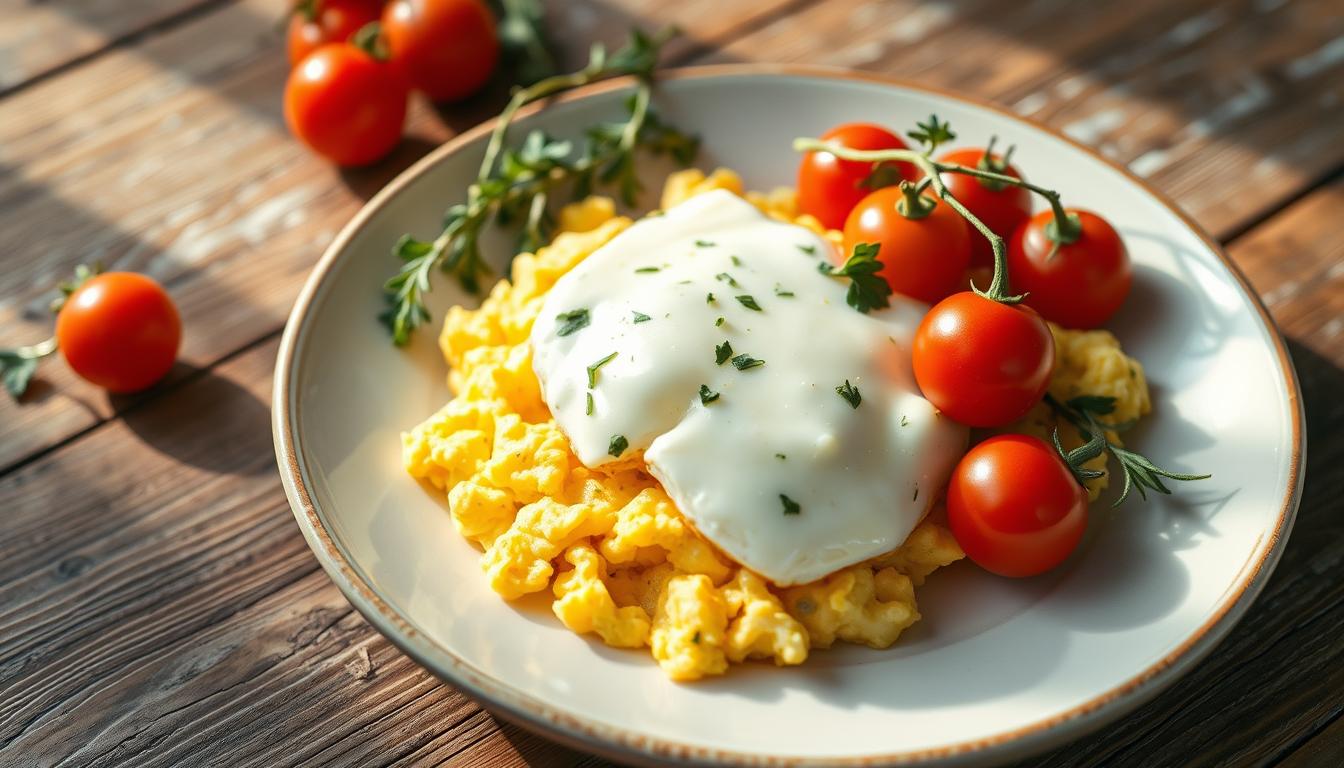Did you know that about 1 in 10 women in the U.S. have endometriosis? This condition affects an estimated 176 million women worldwide. Finding tasty and healthy meals is key for those with endometriosis.
That’s why we’re excited to share a recipe that’s both satisfying and good for you. It’s our endometriosis-friendly breakfast: eggs with lactose-free cheese. This dish is great for those on an anti-inflammatory diet or trying to manage endometriosis symptoms through diet and lifestyle.
Endometriosis-Friendly Breakfast: Lactose-Free Frittata
When you have endometriosis, eating the right foods is key. Our lactose-free frittata is a tasty and healthy breakfast choice. It’s filled with ingredients that fight inflammation and help ease symptoms. You can add your favorite veggies and dairy-free cheese for a great start to your day.
Ingredients and Preparation
To make this endometriosis-friendly frittata, you’ll need:
- 3 organic or free-range endo friendly eggs
- 200g of broccoli florets, rich in sulforaphane to support hormone balance
- 100g of organic lactose-free cheese or a dairy-free cheese alternative
- 1 medium sweet potato, diced
- 1 onion, diced
- 100ml of kefir or lactose-free Greek yogurt
- Salt and pepper to taste
First, preheat your oven to 375°F (190°C). In a large, oven-safe skillet, cook the diced sweet potato and onion until they’re soft, about 5-7 minutes. Then, add the broccoli florets and cook for 2-3 more minutes.
In another bowl, mix the eggs and kefir or yogurt. Pour this mixture over the veggies in the skillet. Sprinkle the lactose-free cheese on top.
Put the skillet in the oven and bake for 15 minutes. The frittata should be set, and the cheese should be melted and bubbly. Serve it hot and enjoy a nutritious, endometriosis-friendly breakfast!
Endo Friendly Eggs Lactose-Free Cheese: A Delicious Combo
For those with endometriosis, a mix of endo-friendly eggs and lactose-free cheese is a big win for breakfast. Eggs are packed with protein and iron, which are often missing in diets of those with endometriosis. Pairing these nutrient-dense eggs with lactose-free cheese makes a tasty, endo-friendly meal. It’s easy to add to many recipes.
This combo is great for gut health. Lactose-free cheese, made from almond, cashew, or coconut milk, is easier to digest. By skipping traditional dairy, people can reduce gut upset and ease some symptoms of endometriosis.
Endo-friendly eggs and lactose-free cheese open up many meal options. You can make frittatas, quiches, omelets, or baked egg cups. These ingredients can be mixed with anti-inflammatory foods to make dishes that are good for the body and help with symptoms.
Using endo-friendly eggs and lactose-free cheese, people with endometriosis can enjoy tasty, gut-friendly meals. This combo is a smart way to manage symptoms through a healthy diet.
The Importance of a Low FODMAP Diet for Endometriosis
Endometriosis is a chronic condition that affects many women’s digestive health. Studies show that a low FODMAP diet can help manage symptoms, like gut issues. Understanding FODMAPs and their impact on gut health is key for those with endometriosis to ease their digestive problems.
Understanding FODMAPs and Gut Health
FODMAPs are hard-to-digest carbs that can cause trouble for some. For those with endometriosis, cutting down on these foods can lessen gut symptoms. This includes bloating, pain, and changes in bowel movements. By eating fewer high-FODMAP foods, the gut can heal, leading to better digestion and less inflammation.
- A study of 156 Italian women with endometriosis showed symptom improvement with a 12-month gluten-free diet, which is often low in FODMAPs.
- In a 2017 study, 75% of women with both endometriosis and irritable bowel syndrome (IBS) had a 50% or more improvement in their bowel symptoms with the low FODMAP diet.
- The Mediterranean diet, which is generally low in FODMAPs, has shown promise in assisting women with endometriosis by reducing pain during periods, intercourse, and improving bowel movements.
By following a low FODMAP diet, people with endometriosis can ease digestive pain, reduce inflammation, and boost gut health. This can help manage their condition better. Learning about the benefits of a low FODMAP diet is a step towards better digestive health and managing endometriosis.
Customizable Egg Muffins: A Meal Prep Solution
Managing endometriosis can be tough, but meal prepping helps a lot. That’s why we’re excited to share our tasty and flexible recipe for endo friendly eggs in egg muffin form. These easy-to-carry, make-ahead bites are full of nutrients to help us stay healthy.
Filling Options and Storage Tips
Our egg muffins start with eggs, lactose-free cheese, and seasonings. Then, you can add anything you like. Try adding sautéed endo friendly veggies, diced dairy-free cheese, or lean protein like turkey or ham. Pick ingredients that fit your diet and taste.
- Whisk together eggs, lactose-free milk, salt, and pepper in a large bowl.
- Grease a muffin tin and spoon the egg mixture into the wells, leaving a bit of room at the top for your fillings.
- Add your desired toppings, such as diced bell peppers, spinach, or crumbled endo friendly eggs.
- Bake at 350°F for 20-25 minutes, or until the eggs are set.
- Let cool, then store the muffins in an airtight container in the fridge for up to 4 days or in the freezer for up to 3 months.
Reheat the egg muffins in the microwave or oven when you’re ready. They’re perfect for quick breakfasts or snacks all week.
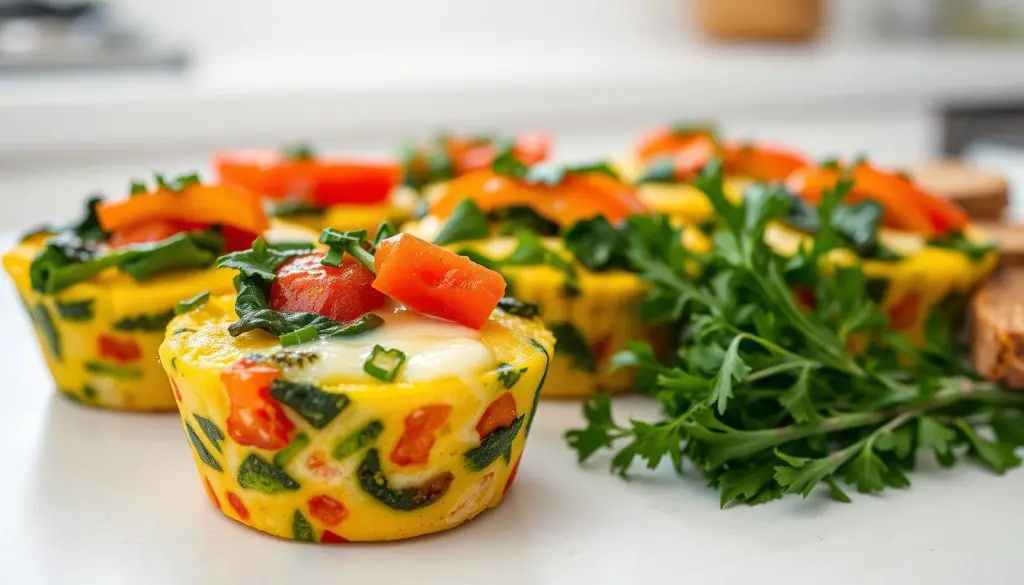
Adding these endo friendly eggs to your diet is a big step towards managing endometriosis. Try different fillings and enjoy the ease of these customizable egg muffins!
Gluten-Free and Dairy-Free Breakfast Ideas
Finding gluten-free and dairy-free breakfasts can be tough. But, with some creativity, we can enjoy tasty morning meals that are good for our bodies. Let’s look at some gluten-free and dairy-free breakfast ideas that help with endometriosis symptoms.
A gluten-free breakfast sandwich is a favorite of ours. Use a homemade gluten-free pancake or waffle as the bread. Add scrambled eggs and dairy-free cheese for a filling breakfast. This recipe is simple and can be changed up with different toppings.
Gluten-free and dairy-free porridge is another great choice. Make it with gluten-free oats, almond milk, and your favorite toppings like banana slices and cinnamon. For something more filling, try a sweet potato porridge with coconut milk and maple syrup.
- Gluten-free pancakes with dairy-free toppings like fresh berries and maple syrup
- Smoothie bowls featuring a blend of dairy-free milk, frozen fruit, and chia seeds
- Baked or sautéed gluten-free and dairy-free veggie frittatas
Trying these gluten-free and dairy-free breakfasts can help us feel better while managing endometriosis symptoms. By choosing whole, nutrient-rich foods, we can start our days off right and support our health.
Anti-Inflammatory Ingredients for Endometriosis Relief
Eggs, Vegetables, and Healthy Fats
Eating foods that fight inflammation can help with endometriosis symptoms. Eggs are full of nutrients that can lower inflammation. Adding vegetables and healthy fats to your meals can help manage endometriosis better.
A Mediterranean diet, rich in vegetables, whole grains, and low-mercury seafood, can improve symptoms. Also, dairy products might help, showing the importance of an anti-inflammatory diet.
- Eggs are rich in folic acid, choline, zinc, and vitamin D, all vital for managing endometriosis.
- Leafy greens, cruciferous vegetables, and other plant-based foods are full of antioxidants and fiber, fighting inflammation.
- Healthy fats in avocados, nuts, and seeds help reduce inflammation and support health.
Adding these anti-inflammatory foods to your meals can help manage endometriosis. A personalized diet plan with a registered dietitian can make it sustainable and effective.
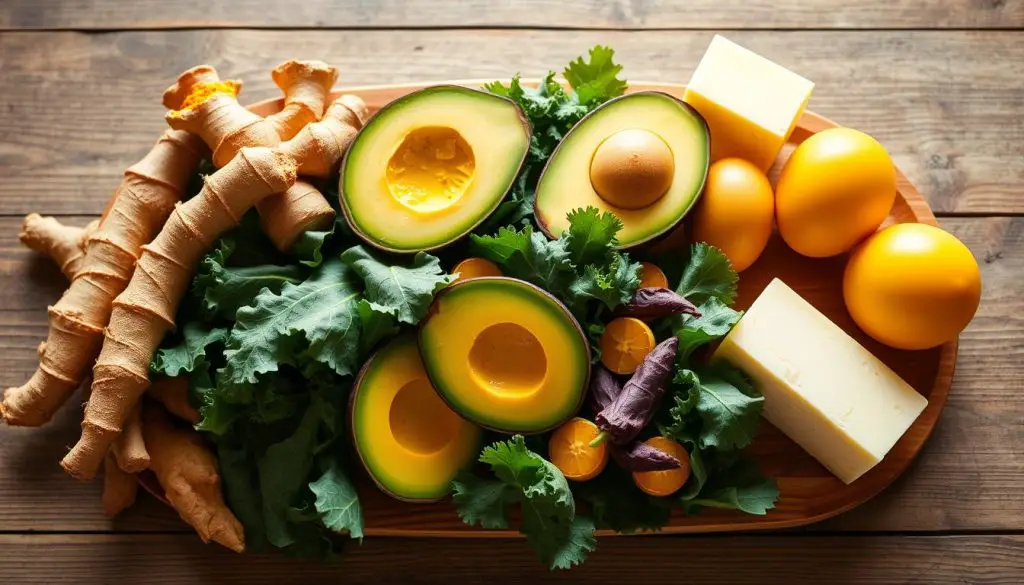
Lactose Intolerance and Dairy-Free Cheese Alternatives
People with endometriosis often have trouble with lactose intolerance. This makes it hard for their bodies to digest dairy sugar. Symptoms like bloating, gas, and pain can make endometriosis worse. Luckily, there are many dairy-free cheese options that can help.
These cheeses, made from cashews, almonds, or coconuts, are free from lactose. They taste and feel like real cheese but don’t cause the same problems. This means people with endometriosis can enjoy their favorite flavors without the discomfort.
Exploring Dairy-Free Cheese Alternatives
- Cashew-based cheeses are a favorite because they’re creamy and rich, just like dairy cheese.
- Almond-based cheeses have a nutty taste and a firmer texture, perfect for spreading.
- Coconut-based cheeses add a tropical twist with their sweet and creamy flavor.
| Dairy-Free Cheese Alternative | Calcium Content | Lactose Content |
|---|---|---|
| Cashew-based cheese | 200-300 mg per serving | Lactose-free |
| Almond-based cheese | 150-250 mg per serving | Lactose-free |
| Coconut-based cheese | 100-200 mg per serving | Lactose-free |
These dairy-free cheeses are not just for those with lactose intolerance. They also have calcium and healthy fats, which are good for everyone. Adding them to your diet can help with endometriosis symptoms. This way, you can enjoy tasty meals without the dairy problems.
Meal Planning for Endometriosis: Tips and Tricks
Living with endometriosis can be tough, but meal planning helps manage symptoms. It’s important for 1 in 10 women in the U.S. to find the right nutrition. This helps balance nutrition and symptom control.
Using a low-FODMAP diet is a good strategy. It has helped 72% of people with endometriosis see big improvements in bowel symptoms. This diet limits carbs that can upset the stomach, improving gut health and reducing inflammation.
It’s also key to focus on essential vitamins and minerals. Eating more vitamin D and dairy can lower endometriosis risk. Vitamins E and C may also help with chronic pain and inflammation.
Getting creative with meals is important. Oatmeal with fresh fruit and chia seeds is a great breakfast. For lunch, try a salad with grilled chicken and veggies in olive oil. Dinner can be baked salmon with spinach and brown rice for omega-3s and iron.
Exercise is also vital for managing symptoms. It helps lower estrogen and releases endorphins, easing pain and discomfort.
Meal planning for endometriosis might seem hard, but it’s doable. Focus on anti-inflammatory foods and be creative. Remember, everyone’s needs are different, so be patient and flexible in finding what works best for you.
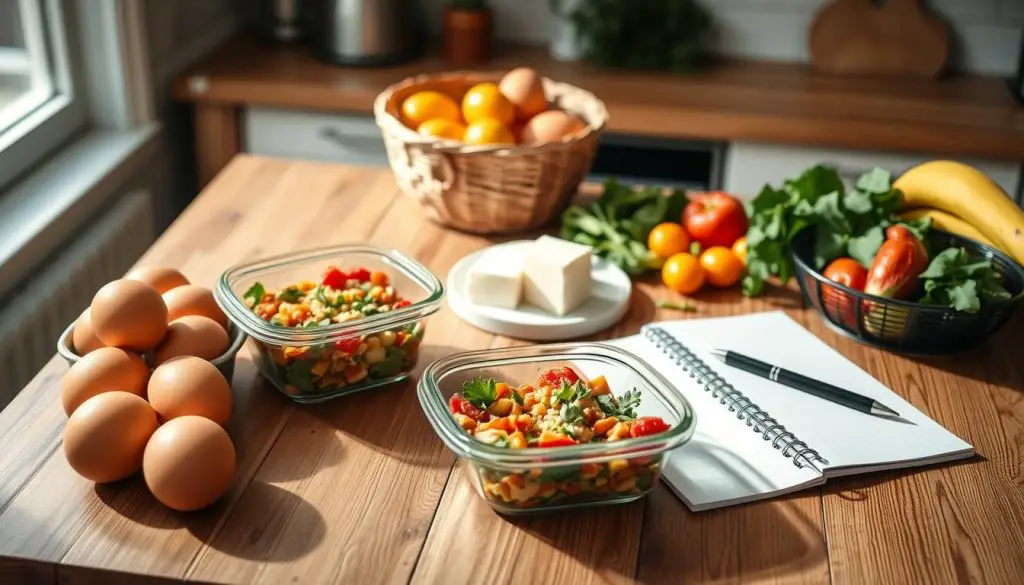
Endometriosis Diet: Balancing Nutrition and Symptom Management
Managing endometriosis through diet is key to overall care. The endometriosis diet can seem daunting with its many foods to eat and avoid. Yet, many women find relief from bloating, endo-belly, and pain by following a special meal plan.
Incorporating Plant-Based Proteins
Plant-based proteins are a big part of the endometriosis diet. Foods like lentils, beans, and quinoa are full of nutrients and help fight inflammation. They offer a healthy alternative to animal-based proteins, which can sometimes cause inflammation.
- Lentils: A versatile legume rich in fiber, folate, and iron, which can help regulate hormone levels and reduce bloating.
- Beans: A great source of plant-based protein, as well as beneficial antioxidants and anti-inflammatory compounds.
- Quinoa: A gluten-free, nutrient-dense grain that provides complete proteins, helping to support overall wellness.
Adding these plant-based proteins to your meals can be tasty and fulfilling. It helps you meet your nutritional needs while managing symptoms.
Gut-Friendly Recipes for Endometriosis Sufferers
Living with endometriosis means keeping a gut-friendly diet is key. It helps manage symptoms and boosts health. We’ve put together tasty recipes that help your gut and ease endometriosis challenges.
Try our Vegan Chili for a fiber-rich, anti-inflammatory meal. Or, enjoy our Cauliflower Tikka Masala for creamy comfort without dairy. Our Red Lentil Keema is a protein-rich, plant-based curry.
These recipes aim to please your taste buds and support your digestive wellness. Adding them to your diet can help control endometriosis symptoms. It’s a step towards a better life.
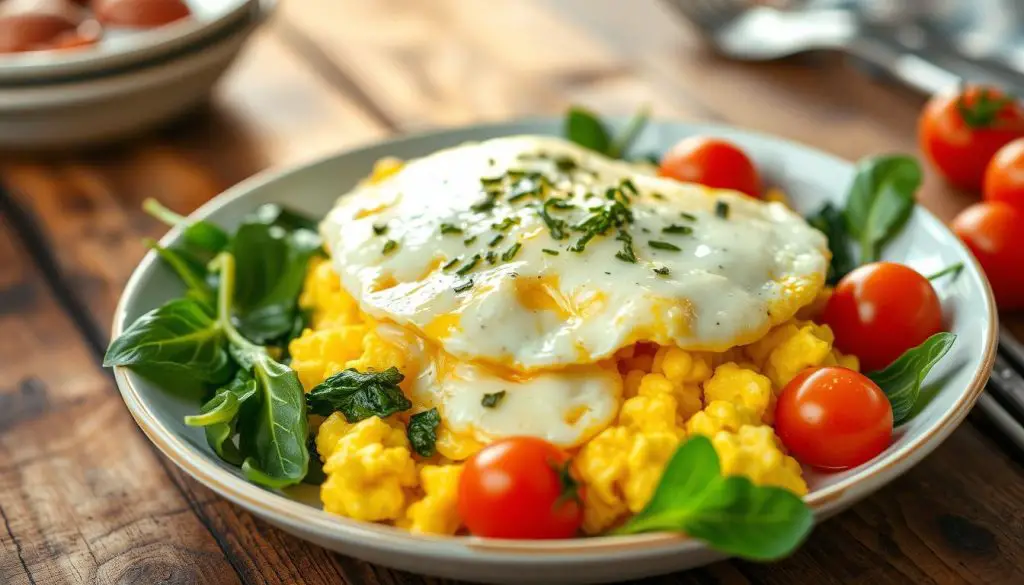
A diet full of anti-inflammatory foods can change your endometriosis journey. Check out these gut-friendly recipes. Start your journey to better digestive health and symptom management.
Egg Substitutes: Vegan Options for Endo Dishes
For those with endometriosis, finding egg substitutes is key. Eggs can cause inflammation and discomfort. Luckily, there are many vegan egg alternatives for endo-friendly dishes.
Mashed banana is a great option. It has a similar texture to eggs and works well in baked goods and pancakes. Ground flax or chia seeds also work well. They mix with water to create a gel-like consistency, just like eggs.
Plant-based egg replacers like Just Egg or Bob’s Red Mill Egg Replacer are also good. They mimic eggs’ texture and flavor, making them easy to use in endo-friendly recipes.
Trying out these vegan egg substitutes can make cooking fun. You can enjoy your favorite dishes without eggs’ irritation. There are many options to choose from, so find what works best for you.
Remember, a balanced diet is important for managing endometriosis. Using egg substitutes, vegan options, and other endometriosis-friendly ingredients helps. You can make tasty meals that help your body and ease your symptoms.
Lactose-Free Cheese: Exploring Dairy Alternatives
Many people with endometriosis find that dairy worsens their symptoms. Luckily, there are many lactose-free cheese alternatives. These options have the same creamy texture and taste as regular cheese but don’t upset the stomach. Let’s look at cashew, almond, and coconut-based cheeses and how they can fit into endometriosis-friendly recipes.
Cashew, Almond, and Coconut-Based Cheeses
Cashew-based cheeses are loved for their creamy texture, similar to dairy cheese. They’re great in dishes like endometriosis-friendly frittatas, lasagna, and mac and cheese. Almond-based cheeses are firmer and crumblier, perfect for salads and other dishes. Coconut-based cheeses add a tropical flavor, making meals more exciting.
When trying these dairy-free cheeses, check the ingredients for common endometriosis triggers like high-FODMAPs. Choosing lactose-free, low-FODMAP cheeses lets people with endometriosis enjoy their favorite tastes and textures. Mixing these cheeses with other anti-inflammatory foods can greatly help manage endometriosis symptoms through diet.
Source Links
- https://www.ssmhealth.com/SSMHealth/media/Documents/slucare/services/obstetrics-gynecology-womens-health/endometriosis-diet-booklet.pdf
- https://healthunlocked.com/endometriosis-uk/posts/143148661/endometriosis-diet-meal-ideas-informative-post-add-yours-to-it-and-share
- https://www.everydayhealth.com/diet-nutrition/endomorph-diet/
- https://www.healthywomanstyle.com/broccoli-rice-leek-and-potato-frittata/
- https://www.fertilityfriends.co.uk/threads/endo-diet.274739/page-5
- https://endoedibles.com/?p=107576
- https://thedietologist.com.au/endometriosis-diet-myths/
- https://thedietologist.com.au/best-diet-for-endometriosis/
- https://joythebaker.com/2019/03/six-weekday-meals-im-eating-right-now/
- https://www.usenourish.com/blog/low-fodmap-meal-plan
- https://jessicaeatsrealfood.com/whole30-meal-prep-egg-muffins-dairy-free-gluten-free/
- https://forum.tudiabetes.org/t/breakfast-ideas/14403
- https://www.everydayhealth.com/diet-nutrition/best-breakfasts-for-people-on-weight-loss-medications/
- https://www.verywellhealth.com/endometriosis-diet-7105372
- https://drkathleenmahannah.com/blog/endometriosis-foods-to-eat-and-avoid
- https://sofreshnsogreen.com/recipes/endometriosis-diet-recipes/
- https://www.everydayhealth.com/digestive-health-pictures/food-substitutes-for-lactose-intolerance.aspx
- https://www.usenourish.com/blog/endometriosis-diet-grocery-list
- https://www.healthline.com/health/endometriosis/endometriosis-diet
- https://www.health.com/condition/endometriosis/endometriosis-diet
- https://www.endo-resolved.com/endometriosis-diet-basics.html
- https://centrespringmd.com/soothe-endometriosis-symptoms-with-these-5-simple-dietary-changes/
- https://www.healendo.com/food-inspo
- https://www.bswhealth.com/blog/endometriosis-diet-what-to-eat-if-you-have-endometriosis
- https://www.lemon8-app.com/gentrygeis/7257766753827176965?region=us
- https://www.everydayhealth.com/diet-nutrition/best-egg-substitutes-for-cooking-baking-and-more/
- https://www.ncbi.nlm.nih.gov/pmc/articles/PMC6471712/
- https://foodbabe.com/organic-milk/comment-page-1/
- https://www.healthline.com/nutrition/vegan-diet-guide
